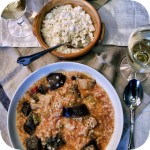

Zucchini in Greek cuisine is ubiquitous. Kolokithopita is a little known Greek way to use this popular vegetable in Poland. Kolokithopita in taste is very subtle and delicate, so combining it with, for example, tzatziki sauce will cause that the garlic contained in the sauce will dominate its taste.
1. The preparation of this dish begins with a clash of unpeeled zucchini without a seed plug on a grater with large mesh. The zucchini should be salted and after 10 minutes, carefully squeezed out of the water.
Heat the oil in a frying pan and add the finely chopped spring onions, fry for about 5 minutes until tender, then pour the rice. Stir and fry for 1 minute so that the rice is covered with oil, then pour in a pan vegetable decoction. Cook on low heat for 15 minutes, so that the rice will absorb the decoction. As the rice will be slightly harder, put together a pan of fire, add zucchini and leave it to cool after mixing.
2. To the cooled zucchini with rice, add the rest of the ingredients: parsley, mint, mixed eggs and crushed feta. Season the whole with salt and pepper and mix thoroughly.
3. Now it's time to prepare a deep form in which we will bake kolokithopita. The inside of the dish must be covered with a thin layer of melted butter. Then apply one piece of filo to the bottom and sides of the dish and then coat it with a small amount of melted butter. A thick silicone brush will be useful for this. In this way, we put in 1-2 more filo sheets, each glued with melted butter.
4. On a dough prepared in this way, we spread the mass with zucchini equally and the protruding edges of the filo pastry wrap into the inside of the mold. The whole is covered with the remaining filo sheets. Remember to lubricate each of them with melted butter. The top layers of the dough can be cut with a knife into smaller squares. This will facilitate the subsequent cutting of the casserole. However, if you do not do it, it will not be bad either.
5. Bake Kolokithopita in an oven preheated to 190 ° C for about 35 minutes, until the dough is browned. We give it hot.



I have never had a good opinion about stuffed vegetables. I always associated them with a bland and not very tasty dish. Until I came across a Greek way to prepare stuffing. The proportions and its ingredients are excellent, so stuffed peppers for good has settled on our table. And the Greeks once again proved that they know how fantastic vegetables can be made. The dish needs a lot of ingredients, but the compilation tastes great, so you should not eliminate anything. If you get some stuffing, you can use it to stuff tomatoes. It will also be good, although the pepper works better due to the specific, distinctive taste. As in the case of other dishes in which feta occurs, do not use its Polish or German substitutes, because these cheeses taste completely different than the original Greek feta, which combined with a large amount of herbs clearly enliven the taste of the dish.

Ladenia is a traditional olive cake popular on the island of Kimolos and neighboring Milos, although we happened to eat it in Crete. It looks like an Italian pizza, but ladenia is a bread cake with oil, onions and tomatoes. There is no cheese, and the cake should not be thin.

Today, we offer aubergines stewed with a sauce with this addition. Instead of xinochondros you can possibly add equally popular trahanas, but in our opinion then the dish gets too bland and requires stronger seasoning. In our opinion, Xinochondros fits much more into this dish. Both xinochondros and trahanas can of course be bought in Crete in typical grocery stores.
Komentarze
komentarz z
Może być jeszcze pita z serem owczym,ze szpinakiem albo serem i szpinakiem☺.Każda pyszna
komentarz z
I wiele innych :) Grecy potrafią w filo przyrządzić chyba wszystko :)
komentarz z
Wiem.Miałam to szczęście ,dzieciństwo spędziłam wśród nich. ☺
Wypełnij poniższy formularz aby dodać komentarz
lub kliknij w poniższy link aby skorzystać z możliwosci komentowania przez facebooka:
https://www.facebook.com/crete.poland/posts/10153926709497551